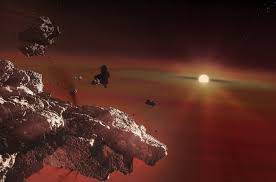Astronomers are looking for the bones of dead planets inside the corpses of dead stars — and they may have just found some.
Source: Live Science
In a paper published Feb. 11 in the journal Nature Astronomy, a team of researchers described how they used data from the Gaia space satellite to peer into the atmospheres of four white dwarfs — the shriveled, crystalline husks of once-massive stars that burned through all their fuel. Swirling among the hot soup of hydrogen and helium surrounding those stars, the team detected clear traces of lithium, sodium and potassium — metals that are abundant in planetary crusts — in the precise ratio that they’d expect to find inside a rocky planet.
“Comparing all these elements together against different types of planetary material in the solar system, we found that the composition was distinctly different from all but one type of material: continental crust,” lead study author Mark Hollands, an astrophysicist at the University of Warwick in England, told Live Science in an email.
According to Hollands and his colleagues, the presence of these crusty metals suggests that each of the old, faded stars they analyzed may have once sat at the center of a solar system not so different from ours; then, in their dying eons, those stars ripped their solar systems to shreds and gobbled up the remains.
Our solar system, too, may share this fate.
When stars die
Over billions of years, stars with masses between about a one-tenth and eight times the mass of the sun burn through their nuclear fuel. When this happens, those old stars shed their fiery outer layers and shrivel into a hot, white, compact core that packs half a sun’s-worth of mass into a ball no wider than Earth — a white dwarf.
These smoldering balls of energy have an extremely strong gravitational pull and are incredibly hot and bright — at first. But the older a white dwarf gets, the cooler and duller it gets, and the more wavelengths of light become visible in its atmosphere. By studying those wavelengths, scientists can calculate the elemental composition of that star’s atmosphere.
Most white dwarf atmospheres are dominated by either hydrogen or helium, the researchers said, but they can become “polluted” by other elements if the dead star’s intense gravity draws in material from the space around it. If a white dwarf happens to suck in the chunks of a broken planet, for example, then “any elements in the destroyed object can release their own light, giving a spectral fingerprint that astronomers can potentially spot,” Hollands said.
In their new paper, Hollands and his colleagues targeted four old white dwarfs within 130 light-years of Earth, to see if their atmospheres carried any evidence of planetary remains. Each dead star was between 5 billion and 10 billion years old, and cool enough for the astronomers to detect wavelengths of light emitted by metallic elements shining out of their dim atmospheres.
In all four old stars, the researchers detected a combination of lithium and other metals that closely matched the composition of planetary debris. One star, which the team caught an especially clear view of, contained metals in its atmosphere that “provided an almost perfect match to the Earth’s continental crust,” Hollands said.
To the researchers, there is only one logical explanation: The old white dwarfs still hold the smoldering remains of the very planets they once shined their light upon. To end up in a white dwarf’s atmosphere, those planetary remains must have been pulled in by the star’s intense gravity millions of years ago, after the star finished its stint as a red giant and jettisoned its outer layers of gas into space, Hollands said.
Any planets close to the star would have been obliterated during the red giant phase (just as Mercury, Venus and possibly Earth will be swallowed up by our sun in its dying days), but any planets that survived long enough to see their sun become a white dwarf would also see their solar system’s gravity go haywire.
“After the red giant phase has ended and the sun has become a white dwarf, planetary orbits can become more chaotic as the white dwarf sun has only half of its former mass, and the planets are now farther away,” Hollands said.
This gravitational disruption increases the risk of planetary collisions, he added, which could fill the solar system with broken, rocky remains of dead worlds. Larger, outer solar system planets (like Jupiter, for example) could then exert their own powerful gravity to send those remains flying out of orbit; some of them might end up close enough to the white dwarf sun to get sucked in and amalgamated.
While something along these lines seems to have occurred around the four white dwarfs that Hollands and his colleagues studied, it’s anyone’s guess whether Earth will ever meet a similar fate. According to study co-author Boris Gaensicke, also a professor at the University of Warwick, it’s likely that our planet will get swallowed up during the sun’s red giant phase, leaving no elements behind for alien astronomers to detect.
However, that doesn’t mean those extraterrestrial telescopes will come up empty-handed.
“I wouldn’t bet on those alien astronomers detecting the lithium of all the defunct Teslas in the solar white dwarf,” Gaensicke told Live Science. “But, there is a good chance that they could see asteroids, comets, moons or even Mars being gobbled up.”
Source: Live Science

































Leave a Comment
You must be logged in to post a comment.